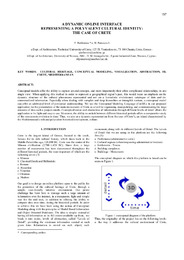A Dynamic Online Interface Representing a Polyvalent Cultural Identity: The Case of Crete
Abstract
Conceptual models offer the ability to capture several concepts, and more importantly their often complicated relationships, in one single view. When applying this method in order to represent a geographical region's past, this would mean an emphasis on the dynamic structure of the cultural phenomena represented and not on a formalistic evolutionary catalogue of data and decontextualized information. Especially when dealing with complex and deep hierarchies or intangible notions, a conceptual model can offer an additional level of perceptual understanding. We use the Conceptual Modeling Language (ConML) in our proposed application for the presentation of the main monuments of Crete as a tool for organizing, manipulating, and communicating the large amounts of data such a project entails. Conceptualization and abstraction of information through different levels of detail allows the application to be light and easy to use. Moreover, the ability to switch between different historical periods offers a comparative study of the monuments evolution in time. Thus, we aim at a dynamic representation from the user of Crete's, an island characterized by the Mediterranean's rich and polyvalent historical development, culture.
Collections
- Συνέδριο Euromed [68]
